
|
|
| |
- The Ranch SkyDiving Boogie and Symposium 2012
- P3 100 way and 150 way camps
- Shake the Bag – 28th to 29th August 2012
- Speed Skydiving? What's it all about then?
- Flight Club and Soul Event
- Aero Club Annual Awards
- Licences and Ratings issued
- PASA MOPs update
|
|
|
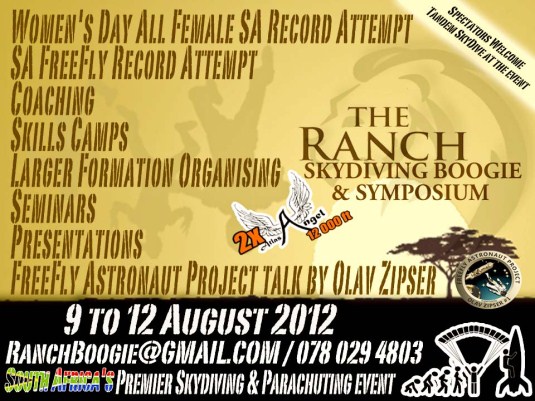
|
|
Showcasing the 'FreeFly Astronaut Project' (Highest Fastest Longest Skydive Ever) Presentation.
When: Thursday 9th to Sunday 12th August 2012 – incorporating National Women's Day.
Where: Protea Hotel Ranch Resort (25km south of Polokwane), Limpopo Province, South Africa.
Hosted by SkyDive Rustenburg at the luxurious Protea Hotel Ranch Resort, the 'Ranch SkyDiving Boogie and Symposium' is regarded as South Africa's Premier Skydiving and Parachuting event.
A highlight of this year’s symposium will be a presentation on the 'FreeFly Astronaut Project' by Olav Zipser.
Olav is respectfully known as the 'Father of FreeFly', and is one of the more interesting and accomplished skydivers in the world. Shortly after The Ranch Boogie he will put on his specially designed Supersonic Spacesuit and ascend in an Interorbital Rocket (at a ridiculous speed) to 131 000ft. From the edge of space he will then FreeFly back to earth. Breaking the sound barrier with his physical body he will set new records for the highest, longest, and fastest skydive ever - one time! And that is just the first of a planned series of increasingly higher altitude rocket launches, culminating with a dive from above the Karman line (100km up!).
The FreeFly Astronaut Project is not a stunt, it is a research mission to amass a new collection of experimental data that will help to create human capability to descend safely from the edge of space.
Olav's FreeFly Astronaut Project is just one of the interesting presentations lined up as part of The Ranch Boogie and Symposium. For those that don't know who Olav Zipser is, check this link (his achievements are listed at the bottom of the link). We are honoured to have the 'Father of FreeFly' at this event.
|
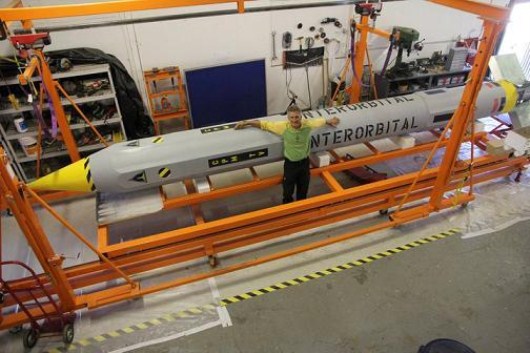
Olav Zipser with the Interorbital Rocket |
|
Skydivers, non-skydivers, aviation buffs, space enthusiasts and members of the public are invited to attend the Ranch SkyDiving Boogie and Symposium to 'discover' what skydiving and parachuting in the 21st Century is all about.
Two Turbine Atlas Angels will be operating continuously from Thursday 9th August (National Women's Day) to late on Sunday 12th August. The Formation Skydiving (FS) Committee are making efforts to set an all Female South African Formation Skydiving Record, and are out to set this on National Women's Day. The Artistic Events (AE) Committee are also going for a new South African FreeFly Record at the event, and the 'Father of FreeFly' will be there to play.
The Canopy Piloting (CP) Committee are hosting a Canopy Skills Seminar; the AE Committee are presenting the new AE MOPS; Thatch is giving a presentation on 'The Effect of Altitude on the Human Physique and Psyche'; Boss Doug is giving a presentation on the 'History of Skydiving Equipment'; and Simba will make a presentation on the '400 Way World Record Largest Freefall Formation'. Additional presentations will be announced at the event.
FS, AE, CP and CRW Coaches are confirmed, and the FS Committee will be assisting with load organising for larger formations.
Presentations on various aspects of skydiving and parachuting, some open for visiting members of the public, will be announced throughout the event.
There is no admission / spectator charge for non-skydivers / visiting members of the public.
Tandem Introductory Skydiving will be offered at the event.
Accommodation specials have been arranged as part of the event - email reservations@theranch.co.za and mention "SkyDiving Boogie" to get special rates.
Event registration for PASA Members is R 400, camping (with own equipment) and use of facilities is included in the registration fee (non-skydiving members of family at no extra charge).
The Saturday Evening Function (at which Olav Zipser is a guest speaker) is open to skydivers and non-skydivers, aviation buffs, space enthusiasts, and members of the public, at a cost of R 280 per person (includes a buffet dinner and entertainment). Tickets available at the event.
Fly Ins:
- Aviators wising to fly into the event are reminded that this is a skydiving and parachuting event, 'single discipline event rules' will apply, which means no flying displays can be permitted.
- Please inform the organisers of the event in advance if you intend flying in.
- The Ranch Resort private airstrip is a 1.2km grass / bush strip running North East / South West and parallel to the golf course. There are no runway lights. GPS - 24°2’34.55”S 29°16’28.15”E
- The event will be NOTAM'ed, paradropping will have priority, parachutes will have right of way.
- Procedure will be to hold at 5NM until comms established with either of the Atlas Angel Jump Ships and / or DZ Ground.
- General Frequency will be 124.8
- AFIS at the event will be provided by Bob Alison (ATC 066)
- Aircraft parking space at The Ranch Resort is limited.
- If aircraft parking space becomes full you may be diverted Polokwane Municipal Airport and collected by road.
- Jet A1 will be available at the event. AvGas and Jet A1 are available at Polokwane International Airport.
Click here for the Full Event Information Document, The PASA Member Information, and PASA Member Registration Form.
FaceBook Group
FaceBook Event
Wikipedia
See you in the Polokwane skies for South Africa's Premier Skydiving and Parachuting event…
|
|
|
|
|
|
|
|
About a year ago Marius Vrey and I took the “crazy” decision to apply for the “Triple Crown” event to be held by P3 at Perris Skydiving in California, USA, over three weeks from beginning of May 2012. We had attended a “Big Way” camp before which was followed by a “Hundred Way” camp, but then we managed to return home only with a partial completion (95). However, that still was a high accomplishment for us as we had only completed something like a 34 way at that stage.
When we arrived, the staff and organizers of P3 who were presenting the “Big Way” camp, welcomed us and gave us a thorough heads-up on what to expect. The first, middle and last thing of importance here was to be safe and have fun while doing it. These guys impressed us with their warm, motivational and professional approach in hosting these events. Very few details got past them and NO safety related issues went by unnoticed. For one, you could not just turn and track. There was an assigned Tracking Group Leader who would lead his group to safety. This group stays together from break off at 7500 feet and track in touching distance from one another until 4500 feet where they should start to fan out to clear for deployment. Now THIS was cool!
The “Big Way” camp was a “learning” camp. You were expected to make mistakes so you and fellow skydivers could learn from these mistakes. This went exceptionally well and in total we did 18 jumps for the duration of this camp. A thorough video debrief would be held after every jump. Every afternoon all the organizers would line up, call everyone together and discuss the events of the day. It also is custom to include the celebration of new “round numbers” as Kate Cooper (one of the event organizers) would call it, being 500th, 5000th jump or whatever the case may be.
The training and experience you built up at this camp was phenomenal! We started off with 30 way formations and ended up by completing a 60 way formation at the end of the camp. This really was cool! After the “Big Way” camp, you get three days to wander off and see some of the USA. There is a LOT to see within driving distance, such as Universal Studios (where they make the movies), Six Flags (best roller coaster joy rides I have ever experienced), Palm Springs Cable Way (something like Table Mountain on steroids) and the Mid Way Aircraft Carrier which recently got decommissioned and opened as a tourist attraction.
After our three day travel experience, we reported at P3, Perris for the 100 way camp. Although slightly less relaxed than the Big Way camp, you are still supposed to have fun (but in moderation). You are being reminded that this is more serious (more jumpers in the sky) and that this would be the time where it would be advisable to apply whatever you have learned and took ownership of during the Big Way camp prior to this one. We had approximately 160 jumpers who had registered for the 100 way camp. P3 would break the camp up in a 100 Way and a 60 Way formation. Marius Vrey and I were both approved for the 100 Way camp!!!
|
 |
|
We started jumping at a higher altitude (16500 feet) and we were briefed on how to use the oxygen equipment for this purpose. I was really not feeling myself that first day (I’ll blame it on flu or something). First, I flew a rather “messy” approach, not quite on my radial. (Boet, if there is ONE thing you don’t mess around with on a “Big Way” formation, it is your radial (line of approach). The second thing that goes with that, is your “stadium” (height of approach, somewhat of a “glideslope” to the docking slot). Well, on jump one I managed to test and fail the first rule and on jump two, the second, causing me to miss a grip and drop on the formation (I still think it floated on me :)). However, I did manage to get back into my slot before break-off. This, needless to say, completely unsettled me. I mean, I HAD this! How was this possible?
Dan Brodsky-Chenfeld, who was the main organizer, looked me up where I was busy packing and gave me some good advice. Boet, the bigger the formation, the more you have to CHILL! I was busy reading his book he recently got published, “ABOVE ALL ELSE”, so I thought it wise to listen to him, he just might know what he was talking about. Oh yes, I forgot to mention, he was a world champion in four way, but that was a way smaller formation than this one. However, should you read his book, you will find him to be a man who just NEVER gives up, any goal is achievable, depending on just how much you really want it.
The next day, I followed his advice and man! What a day! We completed three 100 way formations in a row!! Couldn’t believe us doing a “hat trick” on that one!! The following day, some of the jumpers had to stand down for the guys who have proven themselves worthy on the 60 Way, so all could get a go at the 100 Way. Marius and I were not requested to step down. At first, it went slow with guys ending up low, etc, etc (no, I wasn’t one of them). On the last day of the 100 Way camp on the last attempt, we managed to land yet another completed 100 Way!!! Wow! Four 100 Ways completed in the same week! That night, the beer was sweet! (Especially after being informed that we were both approved for the 150 Way “Perris Wheel Formation” camp to follow). We were now officially proud members of the “P3 100 Way Group”.
|
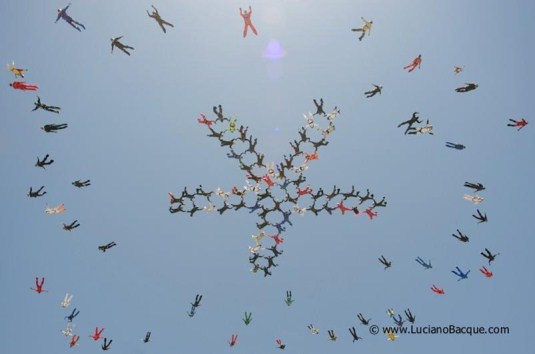 |
|
This time we had a shorter break, only two days. We asked Dan what he would recommend we do on our “weekend pass”. He suggested we go to Las Vegas. However tempting, we thought it wise to avoid that in respect of budget related constraints and to just lie low for the two days. We did, however, visit the Air Museum 10 minutes drive away from Perris Skydiving Club. There was a huge selection of planes, fighter jets etc, one could go and admire.
After our two days of chilling, washing clothes (yes, believe it or not) and shopping for snacks and whatever we thought we could acquire a taste for during the next camp, we reported for the 150 Way INVITATIONAL Camp briefing.
Now, just from meeting the guys registering, I could tell that this was a different ball game. Everyone around us was wearing either 100 Way Club, 200 Way Club or “World Team” badges. Ok, the World Team Formation was a tad bigger than this one – it was a 400 Way.
What immediately struck us was the humble and friendly approach from these guys. I expected them to have a bit of an “air” around them but instead, they were as down-to-earth as any normal person. Lining up in dirt-diving, they would not hesitate to share their knowledge and experience. This was amazing. The next amazement was this formation these guys thought it possible for us to build. This formation had the shape of a wheel with an axle and five spokes, hence the name “Perris Wheel”. Now, THIS seemed to be a tall order. But, the more the organizers briefed us, the closer this “monstrosity” seemed to be an achievable formation. We gave it couple of shots with some entertaining consequences, but on day three (it was a five day camp) we nailed it with 151 jumpers in the formation on the first jump of the day. What an experience! What an indescribable sense of achievement! We did it! One or two more, and then we could maybe add in a second point. Wow! Being part of a two point 151 Way formation just seemed unreal!
The next day we started working toward this, but being over-eager just took its toll. The more we tried, the more complicated it became. Jump for jump we tried until we got to the final jump of the camp. This jump was the final one, our last chance. Everyone was geared for this. We could do it! However, soon after exiting the seven planes flying in perfect formation, we messed up.... Some guys were so low that we wondered if they even took off with us.
Subsequently, we never did get to that second point. HOWEVER, this leaves an achievable goal for yet another day.
To sum it up: Don’t ever think that you cannot do it, because you can! Secondly, don’t make this one of your bucket list items “to do one day” because chances are good that you won’t.
Do it now and get the experience of being part of a selected group of highly disciplined, precision body-flight experts who are a life-enriching experience just to meet.
Life is good, go live it!
Eugene “Pottie” Potgieter
|
|
|
|
|
|
|
|
A chilly Saturday morning at the Johannesburg Skydiving Club was the setting for the much anticipated “Shake the Bag” event hosted by the FS SSA Committee. Skydivers across all levels of FS experience and from various drop zones gathered to get answers to questions such as “Are you in a team yet” and “How do I exit an E from a PAC”? New novice, intermediate and open teams for nationals 2013 was the goal of the event and no one could have predicted how much the bag was going to shake.
|
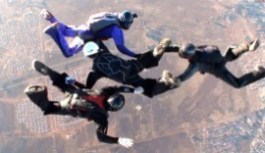
Close of block 22: Warren Dent, Mark Broomhead, Chris Badenhorst, Mike Talerico
(Photo courtesy of Gerome Rich) |
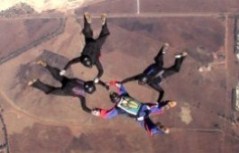
Satellite (O): Bertus Haring, Mohan Chudalayandy, Liza Hietbrink, Chris Moller
(Photo courtesy of Dewaldt Smit) |
|
Saturday saw the weather gods smile on us with blue skies, all loads completed and no incidents apart from some skydivers having to walk a kilometre or two back to the drop zone. With new teams forming and new FS skills being acquired, the vibe at JSC could not have been better and a big party organised by the JSC committee was an awesome end to a perfect skydiving day. But having a good time was not the only priority of Saturday night. Helge Harms generously donated a Javelin rig (with a Hurricane 120 and Smart reserve) to be auctioned off with the proceeds going towards Serafim Fernandes’ costs to represent South Africa in Landing Accuracy World Championships in Dubai later this year. The final bid was closed on R7500. Good luck, Serafim, we’re behind you!
Sunday morning saw teams completing their jumps, a few CAT3 attempts and new teams strategising on budget and potential tunnel time.
All in all over the weekend a total of 26 skydivers with 6 coaches and 5 cameramen completed 33 4-ways and 3 2-ways. New novice, intermediate and open teams have been formed and FS skills have been taken to new levels.
|
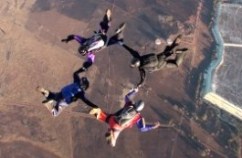
Stairstep Diamond (B): Bailey Edmunds, Erik Voges, Jac van Zyl, Bosman Kruger
(Photo courtesy of Dewaldt Smit) |
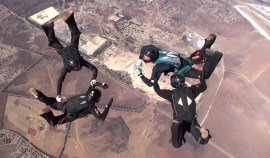
Close of Block 7: Ian van den Berge, Bailey Edmunds, Pam Turner, Michelle Tobias
(Photo courtesy of Ronald Matthee) |
|
To everyone that participated, please keep up the good FS flying. The new SASL season starts next month, loaded with prizes and giveaways so get started early. Need help getting started? Contact the FS SSA Committee and we will help you. That’s our passion! In the mean time, film your jumps and get them debriefed – we will see to it that you get feedback on the footage no matter where in the country you jump.
A big thank you to the coaches, cameramen and JSC who dedicated a lot of their personal time and made us feel welcome. A great weekend at a great drop zone with great people. See you all at “Shake the Bag 2013”.
|
|
If you enjoyed this event or want to join the next one, please support the FS committee by ticking FS on your PASA renewal form. You can do this at any time by emailing the PASA office. FS operates on the smallest budget per member than any other discipline; the tick costs you nothing but allocates more development budget to us to give you events like this.
|
|
|
|

dPhi Wear Online Store
Suppliers of high quality skydiving t-shirts and apparel. Why wait for us to come to your DZ when you can get what you want directly from our website!
Contact: Claire King & Dirk Venter
Website: http://www.dphi.co.za/
Email: sales@dphi.co.za
Telephone: 011 609 6719
|
|
|
|
|
It couldn’t be simpler: Get out of the aircraft and go as fast as you can. It’s the fastest non motorised sport in the world. Double the speed of Formula 1.
It’s a competition event which has been around for about 13 years and, although not yet an official FAI discipline, it is a demonstration event at the Mondial in Dubai this year. (Mondial? That’s all the parachuting world champs at the same place and time. Go and watch if you have a chance)
|
 |
|
Every year there is a Speed Skydiving World Series run by the International Speed Skydiving Association (ISSA). This year is the 12th World Series. The series is three events in different countries, and your best two scores put you in the world rankings for the year. Winners are declared at the end of the third event. This year the events are in Germany, Switzerland and Finland. The events are held over a weekend and are open to anyone. There are competitors at this year’s world series with less than 200 jumps. There were 40 competitors from around the world at the event in Germany in April, and competition was tight. Several nations hold nationals in speed skydiving. You can learn more about the events, see this year’s rankings, and see the full rules at the ISSA website
The ISSA also awards all the world and national records and publishes them on the all time performance table of the best speeds of everyone who has ever competed at speed skydiving. Check it out
As with any competitive event, there are rules so that everyone competes on equal footing. But, being a simple event in principle, the rules are few and are easy to understand. The main rule is that you can’t wear lead. It’s just you and your rig. You might think a big heavy person has an advantage because they’ll obviously fall faster. To start with, up to about 300 km/hr, that’s true. But a big heavy person has a big body and a big rig, and that adds up to more drag surface than a smaller person. If you double your speed you get four times the drag so the big guys have to be very skilful to go very fast. The best would probably be a tall thin person who is heavy because of muscle. But I’m only 167cm and 72kg, and I’m currently 6th in the world rankings, so there must be other factors affecting speed.
From a safety perspective, your rig has to be safe enough to go really fast. All Velcro must be in really good condition. Any flaps on your rig, such as pin covers and riser covers, must be very secure. Your BOC pocket must be tight, although a pull out system is recommended because the airflow can’t get at it. You also probably don’t want a canopy that is known to open very hard. Other than that anything goes.
The event is actually a race over a vertical kilometre, from 2700m to 1700m. That’s about 9000ft to 5700ft. The race starts from 13000ft and you do your best to get as fast as you can before the scoring zone starts, and keep going as fast as you can for the next 3300ft. Then, when you get out of the scoring zone, you pull out of the dive and try to slow down as much as possible before opening. A top speed jumper will be doing 1000ft in about 2 seconds at the end of the zone, which makes the ground only 10 seconds away. So you really get a sense of ground rush. The best top speed I’ve achieved is 520 km/hr, and when I pulled out of the dive and tried to slow down, I’m sure I saw the devil laughing at me.
Your speed is measured by two Pro-Tracks, mounted on each side of your rig on the lateral webbing. The event organisers provide the Pro-Tracks. When a Pro-Track is downloaded into Jump-Track software after the jump, a graph of your speed during the jump is produced, along with your average vertical speed over the 1 kilometre scoring zone. The speeds from the two Pro-Tracks are averaged and that is your score. If the difference in the speeds is more than 30km/hr it means you were flying in such a way that accurate scoring is not possible and you get a zero. A competition is six jumps and your best three count, so you can get three zero’s in a meet and still be on the leader board.
So how do you go fast? Clothing and body position are the main factors. You can go flat, feet first, head down, whatever you like; the rules don’t care. But the fastest speeds have been set in a head down position. Some of the fastest jumpers have their head slightly back which masks some of the air going over the rig, and this seems to give more stability at high speed. But it also puts you in a slight track, about 5 degrees off vertical, which may take away some of the vertical speed. A relaxed body position with the arms by the side and the legs straight seems to be fastest. If you tense up everything gets very unstable at high speed. Low drag clothing is obviously best, but it helps stability if you’ve got a bit of drag on the lower legs. The fastest person at the meet in Germany was wearing a skin tight top and jeans. Some jumpers wear full face helmets and others wear open face. I’ve tried both and there doesn’t seem to be any noticeable change in my speed. I just felt a bit worried that the full face visor would rip off at 500 km/hr, whereas a tight pair of goggles and an open face felt secure. I guess it’s whatever you feel comfortable in.
If you want to try it out at your dropzone then you can do a simplified version. Just get out and see what top speed you can get to. Get out first and aim across the run in so you track away from other jumpers. You’re not allowed to wear lead. Remember to stop early enough so you can slow down before opening. If you don’t have a Pro-Track, borrow one. Make sure it is set for True Air Speed (TAS). Just read the maximum speed off it after the jump. For a bit of competition spirit, keep a board in the bar showing who is the fastest at your dropzone.
|
 |
So what sort of speeds are people getting to? So far only four people have gone faster than 500 km/hr. The current world record is 526.93 km/hr, set by Christian Labhart from Switzerland, and remember that is an average speed over the vertical kilometre. So he must have had a top speed of about 550 km/hr when he pulled out of the dive to slow down. That’s over two and half times the speed of flat flying. To get an idea of how fast that is, imagine standing on the edge of a sheer cliff and a 4-way FS team goes past at normal speed. That would look mind-bendingly fast. Now imagine being in a 4-way and a speed skydiver goes past. It would be even faster. Blink and you miss it. Now imagine being that speed skydiver.
You get out and pitch over smoothly into a head down position with your arms by your sides and your legs straight. The normal falling sensation that last a couple of seconds when you jump out just doesn’t go away. Not for the whole skydive. You never stop accelerating. The first time you try it, after about ten seconds you’ll think you’re going very fast, faster than you’ve ever gone before, and you’ll start getting scared. But you haven’t even started to get fast yet. At fifteen seconds you’ll think the airflow is about to rip your clothes off, and the sound of the air screaming past is louder than standing by the speakers at a Ramstein gig. At about twenty seconds you’ll enter the scoring zone. You’ll have probably given up all hope of surviving by now. The horizon is a blur, the airflow would make the Hiroshima blast seem like a butterfly flapping its wings, and permanent hearing damage will seem guaranteed. You will probably swear at this point. You steer by flexing your fingers and wiggling your toes, because it feels like doing anything else would result in a screaming, flailing, out of control, ball of limbs and ripped clothes. You’re in the scoring zone for about eight seconds if you going fast. That’s 8 seconds for 3300ft. And it just keeps getting faster and louder. You’re going twice as fast as Michael Schumacher has ever done, and you’re doing it without an engine. You know the planet is coming up fast. Very, very fast. At about twenty eight seconds you’re getting near the end of the scoring zone. You’ve given up all hope of getting away with this madness unscathed. And now you’ve got to try and slow down. You flare your nostrils just a bit and it pulls you out into a track that defies belief. People on the ground mistake you for a cruise missile heading for impact. The ground is still coming up alarmingly fast. After a second or so of tracking you’ll have crossed half of Africa and slowed enough to stick your arms and legs out. This is when you find that air at these speeds is not really a gas, it’s more like solid concrete. Your arms feel like you’re doing push ups with an elephant on your back, and you’ll think they are going to come out of their sockets. You slow down as much as you can, and pull when you have to. If you’re not all that good at slowing down, you’ve just got to take the hit. Brutal doesn’t describe it. Then you hang in the harness trying to get your breath back and come to terms with what you just did. It’s quite surreal hanging under a parachute in comparative silence and travelling slowly when you know you’ve just gone fast enough without an engine to do Jo'burg to Cape Town in two and a half hours.
|
|
Speed Skydiving - If you don’t see the Devil, you’re not going fast enough.
Tim Mace
|
|
|
|
|
|
|
|
With SOUL FLYERS Fred Fugen and Vince Reffet @ JSC with PAC Partnership, this October!
Thursday 18 October - Sunday 21 October 2012.
Secure your place!
How much? R1350 non-refundable payment into Johannesburg Skydiving Club's account (JSC banking details available at www.jsc.co.za). Reference: ATMO or WINGSUITING + Name.
|
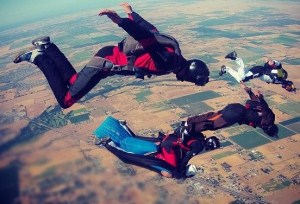 |
|
The event is non profit and funded by combined contribution of participants, and financial sponsorships received, as managed by the organiser Flight Club, and financially managed by JSC.
Registration secures each participant with briefings and debriefings, organized Atmo Angle Flying group coaching loads + organized Wingsuiting loads spread across the 4 days. No additional coaching fees apply. Individual slots rates apply @ R240/slot.
Jump schedule will be released once registration is closed. Maximum number of 40 participants, with 25 registrations already received, so don't delay...!
The Flight Camp will include Atmo Body Piloting group loads, Wingsuiting group loads, and high-level Hybrid Atmo/Wingsuit loads, planned to best accommodate the group participants over 4 days.
This is primarily a skills development opportunity for South African skydivers wishing to participate at the December 2012 International Atmo Record Event in Dubai to train at a high level with the very best.
Whether you are an Atmo Body Pilot, a Wingsuiter, or an interested skydiver wanting to learn or improve Atmo Angle Flying skills... Flight Club invites you to join in on the festivities.
ATMO Agenda:
1. Shallow and steeper angles
2. Contact and no-contact formations
3. Close formations with carving and tight turns in the sky
4. Novice, Intermediate and Advanced loads
5. Record attempts
WINGSUITING Agenda:
1. Steeper angles
2. Alternate body positions and techniques
3. Close formations with carving and tight turns in the sky
4. Record attempts
5. Hybrid loads
Don't miss out on this historic opportunity to fly with the SOUL FLYERS.
Contact Marco for more information, or call 0826006569.
The Sky Is Our Playground tm
Flight Club - Atmo South Africa
|
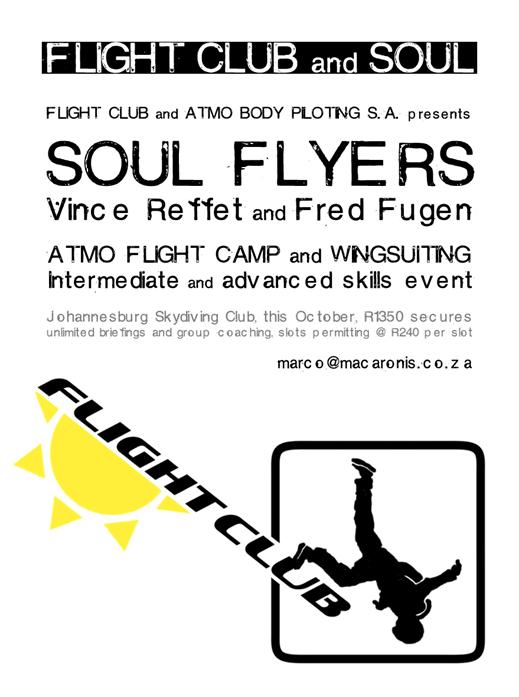 |
|
|
|
|
The 2012 Aero Club Annual Awards dinner will be held in November. A number of awards and trophies are presented at this annual event, including colours for teams who have represented South Africa World Championships, as well as recognition awards for other notable achievements. All sections of the Aero Club may nominate recipients for Aero Club Silver Wings and Aero Club Gold Wings awards. These are prestigious awards and nominees must have had a noteworthy impact on their respective sections within the Aero Club, and on a national basis.
|
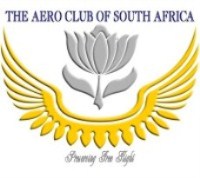 |
|
PASA has a panel, comprising previous winners of the Aero Club Gold Wings award, who consider nominations received and put forward to the Aero Club those that meet or exceed the following criteria:
- The awards are to be respected for the prestigious accolade that they are.
- The Aero Club is a national body - these awards are therefore intended to be bestowed upon people who have had an impact on the sport on a national basis (not just at one local drop zone).
- Only people who have been nominated by members from more than one drop zone around the country will be considered for the awards.
- Nominations for Gold Wings must be for people who have been a force within the sport and on a national basis for a period of at least 10 continuous years.
- Nominations for Silver Wings are for people who have been a force within the sport for at least 5 continuous years and have provided exceptional service or run exceptional projects during that time.
With the above criteria in mind, we ask for nominations for the 2012 Aero Club Gold Wings and Aero Club Silver Wings awards. Nominations are to take the form of a citation outlining why you believe this person deserves the award and highlighting their achievements and/or service. Email nominations to: admin@para.co.za or fax to 021-553-3398. Please ensure that the person you wish to nominate fulfils all the criteria listed above. Nominations for people who do not meet the criteria and/or are not accompanied by a citation cannot be considered.
Without the involvement of the skydiving community, we cannot ensure that those who deserve recognition, receive it - please make every effort to get involved and take a few minutes to nominate someone who has had a positive impact on your skydiving career.
Nominations will be accepted until close of business on Friday, 14 September 2012.
|
|
|
 |
|
Suppliers & Manufactures of fine Skydiving Equipment
|
|
Need Skydiving Gear?
New or Second Hand
Reserve repacks and repairs
Accessories:
Jumpsuits, Parabags, Packing mats, Helmet Bags,
Altimeters - Wrist mount & Audible, Helmets,
Hook Knives, Goggles, Skydiving Videos/DVD's, Skydiving T-Shirts
|
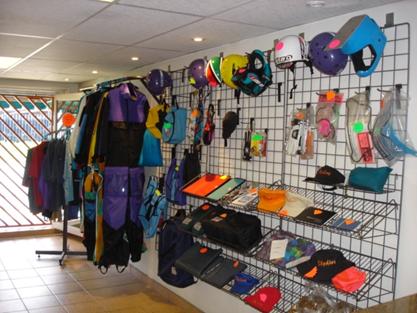 |
|
Visit our Shop
138 - 7th Ave
Edenvale
Gauteng
Contact: Manuel Cordeiro
Website: www.icarus.co.za
Email: manny@icarus.co.za or icarusaw@global.co.za
Telephone: 011-452-8858 / 083-252-8720
|
|
|
|
|
Lic/Rating
|
Name |
Drop Zone
|
| |
|
|
|
A Licence
|
|
|
| A7173 |
Suvarn Naidoo |
Johannesburg Skydiving Club |
|
A7174
|
Bruno Alves |
Johannesburg Skydiving Club |
| A7175 |
Mike Bando |
Witbank Skydiving Club |
| A7176 |
Ilandé Vorster |
Pretoria Skydiving Club |
| A7177 |
Brandon Rothero |
Skydive Port Elizabeth |
| A7178 |
Peter Grove |
Witbank Skydiving Club |
| A7179 |
Daniel van Diermen |
Skydive Robertson |
| A7180 |
Frikkie Geyser |
Pretoria Military Parachute Club |
| A7181 |
Charles Krohn |
Witbank Skydiving Club |
| A7182 |
Hoosein Maal |
Pretoria Military Parachute Club |
| A7183 |
Ricardo Swanepoel |
Skydive Central |
| A7184 |
Owen Mushayi |
Skydive Central |
| A7185 |
Thipa Sekwele |
Skydive Central |
| A7186 |
Mlungiseleli Jokani |
Witbank Skydiving Club |
| A7187 |
Louis Nel |
Witbank Skydiving Club |
| A7188 |
Londani Ntombela |
Witbank Skydiving Club |
| A7189 |
Sibusiso Mhlambi |
Witbank Skydiving Club |
| A7190 |
Charl le Roux |
Witbank Skydiving Club |
| A7191 |
Stephanus Klopper |
Witbank Skydiving Club |
| A7192 |
Renato Reid |
Witbank Skydiving Club |
| A7193 |
Lucian Naran |
Johannesburg Skydiving Club |
| A7194 |
Ludick Jordaan |
Skydive Central |
| A7195 |
Jozanne Dickason |
Witbank Skydiving Club |
| A7196 |
Dewald Gilfillan |
Pretoria Skydiving Club |
| |
|
|
| B Licence |
|
|
| B2820 |
Frederic Body |
Pretoria Skydiving Club |
| B2821 |
Ehan Groenewald |
Skydive Central |
| B2822 |
David Botha |
Skydive Central |
| B2823 |
Louise Cilliers |
Pretoria Skydiving Club |
| B2824 |
Michael Panaino |
Witbank Skydiving Club |
| B2825 |
Mark Daniels |
Johannesburg Skydiving Club |
| B2826 |
Kevin Rielly |
EP Skydivers, Grahamstown |
| B2827 |
Christine Daffie |
Skydive Central |
| B2828 |
Ricardo Swanepoel |
Skydive Central |
| B2829 |
Reinier de Jager |
Skydive Central |
| |
|
|
| C Licence |
|
|
| C1793 |
Johan Roberts |
Witbank Skydiving Club |
| C1794 |
Marinda Munro |
Skydive Central |
| C1795 |
Arenhold Hooper |
Skydive Central |
| C1796 |
Andrew de Jonge |
Skydive Central |
| C1797 |
Neil Brown |
Witbank Skydiving Club |
| |
|
|
| PRO Rating |
|
|
| PRO422 |
Josie Coetzee |
Skydive Rustenburg |
| PRO423 |
Martin Gopane |
Skydive Central |
| |
|
|
| Jumpmaster Rating |
|
| JM1244 |
Martin Gopane |
Skydive Central |
| |
|
|
| Tandem Master Rating |
|
| TM153SG |
Jasper Williams |
Pretoria Skydiving Club |
| |
|
|
| Tandem Master Sigma Conversion |
|
| TM121SG |
Llewellyn Henman |
Skydive Central |
| |
|
|
| |
V = Vector |
|
| |
SG = Sigma |
|
| |
ST = Strong |
|
| |
R = Racer
|
|
| |
|
|
|
Coach Rating
|
|
|
|
CH144F
|
Francois Krös
|
Skydive Central
|
| |
|
|
| |
F = Formation Skydiving |
|
| |
A = Artistic Events
|
|
| |
C = Canopy Formation
|
|
| |
P = Canopy Piloting
|
|
| |
W = Wingsuiting
|
|
|
|
S = Freefall Style & Accuracy Landing
|
|
|
|
|
|
|
Safety & Training has undertaken an exhaustive review and update of the PASA Manual of Procedures. The final documents are currently being lodged with RAASA and, once approved, the updated sections will be uploaded to the PASA website documents section. Quotes will be obtained for getting A5 copies of the MOPs printed. Members will be advised via email listservs and the PASA website home page and we will take orders if sufficient demand exists.
Salient updates:
- Use of AAD mandatory on freefall jumps up to A licence.
- A 4-jump Intermediate Canopy Control Programme has been incorporated into the Intermediate Skills Programme.
- The D licence test option as an alternative to a jumpmaster rating has been removed from D licence applications. Successful completion of a PASA jumpmaster course is now mandatory for all D licence applications.
- Requirements for Wingsuit and Canopy Piloting coaches have been added.
- A new section has been added for Canopy Piloting.
- The Formation Skydiving section has been updated to clarify a few ambiguities. In addition, the advanced body position is renamed the FS optimised body position, provision is made for Category II jumps 1 to 5 to be done in a wind tunnel and the 4 evaluation jumps required to become a FS coach have been replaced with 3 new evaluation jumps.
|
 |
- The Artistic Events section has been updated dramatically. The 7 Category II jumps are replaced with two new jumps which introduce the Basic Sit Position (BSP) and Back-Down Stable (BDS) and focus on maintaining vertical speeds. The Category III test jump is replaced with 2 jumps that focus on fall rate control and horizontal movement. The C and D licence requirements have been overhauled to make them more realistically attainable, and to include head down training jumps. The progression still incorporates an angled flight jump requirement. The separate C and D licences for Freefly and Freestyle have been replaced with one Artistic Events C or D licence as basic head up, head down and angled flight skills form the basis for all AE jumps.
- The Wingsuit section has been updated. The minimum number of jumps required to do a wingsuit course has been reduced to 200. Category I, II and III jump programmes have been added. PASA wingsuit coach requirements and coach course outline have been added.
|
|
|
|
Thank you to everyone who contributed to this issue. If you have any stories, pictures, comments or suggestions please send these to news@para.co.za
If you are interested in advertising in this newsletter, contact admin@para.co.za for more details.
|
|
|
|
PASA and the Toggle Times cannot be held responsible for any errors or omissions, due to all content being submitted without verification.
|
|
|
|

